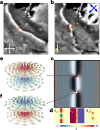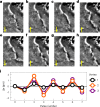Antiferromagnetic half-skyrmions electrically generated and controlled at room temperature
- PMID: 37157021
- PMCID: PMC10427425
- DOI: 10.1038/s41565-023-01386-3
Antiferromagnetic half-skyrmions electrically generated and controlled at room temperature
Abstract
Topologically protected magnetic textures are promising candidates for information carriers in future memory devices, as they can be efficiently propelled at very high velocities using current-induced spin torques. These textures-nanoscale whirls in the magnetic order-include skyrmions, half-skyrmions (merons) and their antiparticles. Antiferromagnets have been shown to host versions of these textures that have high potential for terahertz dynamics, deflection-free motion and improved size scaling due to the absence of stray field. Here we show that topological spin textures, merons and antimerons, can be generated at room temperature and reversibly moved using electrical pulses in thin-film CuMnAs, a semimetallic antiferromagnet that is a testbed system for spintronic applications. The merons and antimerons are localized on 180° domain walls, and move in the direction of the current pulses. The electrical generation and manipulation of antiferromagnetic merons is a crucial step towards realizing the full potential of antiferromagnetic thin films as active components in high-density, high-speed magnetic memory devices.
© 2023. The Author(s).
Conflict of interest statement
The authors declare no competing interests.
Figures




References
-
- Kläui M, et al. Current-induced vortex nucleation and annihilation in vortex domain walls. Appl. Phys. Lett. 2006;88:232507. doi: 10.1063/1.2209177. - DOI
Grants and funding
- 766566/EC | EU Framework Programme for Research and Innovation H2020 | H2020 Priority Excellent Science | H2020 Future and Emerging Technologies (H2020 Excellent Science - Future and Emerging Technologies)
- EP/V031201/RCUK | Engineering and Physical Sciences Research Council (EPSRC)
- DP200101027/Centre of Excellence for Electromaterials Science, Australian Research Council (ARC Centre of Excellence for Electromaterials Science)
LinkOut - more resources
Full Text Sources

